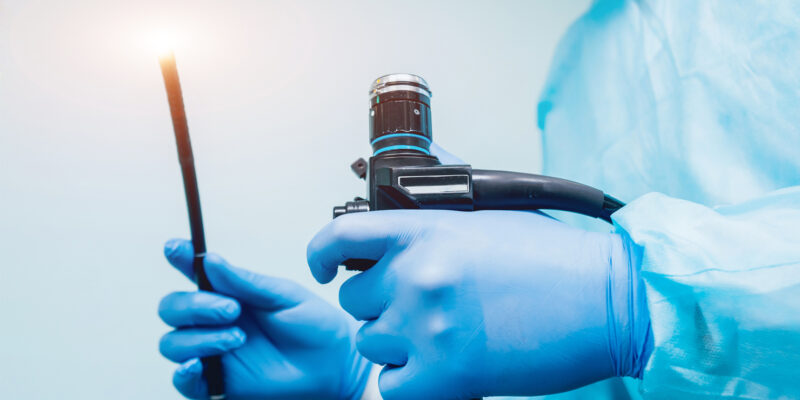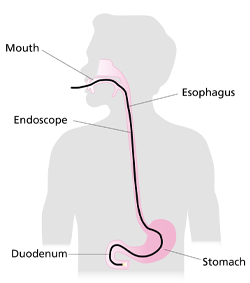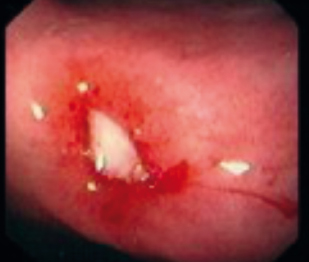
Endoscopy
This leaflet describes the purpose of your procedure and what is involved for you. Please read this carefully before coming for the procedure so that you can be reassured about what will happen when you attend the Endoscopy unit.
Outpatient test – This leaflet should provide you with the all the basic information about the test.
- Some patients are referred directly for a Gastroscopy by their GP or a hospital clinician. In addition to this leaflet, you will be given the opportunity to ask any questions about the procedure.
- Other patients will have been given the opportunity to ask any questions about the procedure when attending either an outpatient clinic appointment before the test or at the hospital pre-assessment visit.
Despite this, occasionally questions about the procedure remain. If you have any major concerns before then you should contact us using the contact details at the end of this leaflet.
In-patient test – The medical and nursing staff responsible for your care will be able to answer your questions regarding the procedure.

What is a gastroscopy?
A gastroscopy, also sometimes called an upper gastro-intestinal endoscopy, ‘OGD’ or simply an endoscopy, is a procedure which allows the endoscopist (person performing the gastroscopy) to pass a flexible tube down through the mouth – over the back of the tongue – to examine the gullet and, or swallowing tube (Oesophagus), stomach and part of the Duodenum (see figure 1).
It is about as thick as your index finger. A small amount of gas is blown into the upper gut to achieve a clear view.
In some cases (and often routinely) it may be necessary to take biopsies (small samples of tissue), using tiny forceps. The samples are sent to the laboratory for analysis using a microscope. Taking biopsies is painless and very safe.
In a small proportion of patients, usually when an abnormality is identified, it may be necessary to use devices that can inject, cauterise, snare or clip an area of the upper GI tract. These devices are passed down a tiny channel within the flexible tube and are again painless and very safe.
How may a gastroscopy help?
This examination allows the endoscopist to obtain a very clear view and thoroughly inspect your swallowing tube (Oesophagus), Stomach and first parts of your small bowel (Duodenum). A gastroscopy is often undertaken if someone has: –
Symptoms of indigestion – particularly if these have failed to respond to standard treatment
Difficulty swallowing
Persistent nausea and vomiting
Passing black motions (melaena) or vomiting blood
Significant weight loss
Follow-up for upper gastrointestinal conditions such as Barrett’s oesophagus, certain types of Stomach inflammation, a previous history of Stomach ulcers or upper gastrointestinal cancer

A gastroscopy tells us if there is any obvious reason for your symptoms (for example; an ulcer) and helps us to work out the best way to treat it. Disease can then be either ruled out or diagnosed accurately.
Do not be surprised if appearances are all normal because many patients have symptoms without any visible abnormality!
Biopsies are often taken and sent to the laboratory for examination – even if no obvious abnormality is seen.
These may, for example, show inflammation or infection.
Is there an alternative?
Your doctor has requested a Gastroscopy because they feel this is the best way of identifying or ruling out a problem in your upper Gastro-intestinal tract. These areas can also be examined by a barium swallow & meal radiological (x-ray) test.
- It would involve you drinking a thick milky like mixture. The outline of the Oesophagus, Stomach and Duodenum will then show up when x-ray pictures are taken of you.
- To co-operate with the test it would be necessary for you to move position several times on the x-ray table.
- No sedation is given.
- This test has even less risk than a Gastroscopy. However, biopsies cannot be taken and so some problems such as mild inflammation and early diseases could well be missed.
- In addition, a Gastroscopy may still be needed if a barium x-ray suggests an abnormality.
- You would be exposed to a small dose of x-ray radiation.
If you think you might prefer this, ask your doctor.
CT scans do not identify problems in the lining of the upper gastro-intestinal tract well and are not really a useful test to identify or rule out most problems in this area. They can sometimes be helpful when the exclusion of a very advanced serious problem is all that is required.
Not having a gastroscopy or an alternative test would limit your doctor’s ability to confirm the cause of your symptoms or condition. You should discuss this very carefully with your doctor. If you decide against having your procedure, then please let the administrative team know so that the valuable appointment can be given to someone else.
What preparation is required?
When you get your appointment
Please review the medications you take well in advance of your procedure. If you take any of the following medications then please contact the department using the details below.
- Anticoagulant medications to thin the blood (Warfarin, Dabigatran, Rivaroxaban, Apixaban or Edoxaban) or anti-platelet drugs (Clopidogrel, Prasugrel or Ticagrelor). Some of these need to be stopped before endoscopic procedures and some require additional treatment if they are to be omitted.
- If you are a diabetic on treatment with tablets or insulin. Special arrangements are necessary if you need insulin.
You should expect to be given the necessary instructions about what to do with these medications in the days before your gastroscopy at the time of booking your test. If you are not given this information, then please ask.
It will be helpful to the endoscopy team if you bring all your medications (or at least a list of these indicating the dose and how frequently they are taken) with you when you attend for your gastroscopy.
On the day of the procedure
To allow a clear view, the gullet, stomach and duodenum must be completely empty. This also makes sure that you do not vomit.
This means that you should not have any food for at least six hours before the appointment time for the gastroscopy. Clear fluid such as black tea, black coffee, squash or water can be taken up to two hours before the procedure.
After this time you must remain “nil by mouth”. This includes not chewing any gum.
Important
What happens in the endoscopy unit?
Your appointment letter gives a time for you to arrive at the Endoscopy unit so that all the administrative and clinical checks can be performed before your procedure takes place.
Please note that although we do our best to work to appointment times the variable nature of the procedures undertaken in the endoscopy unit mean that you may experience a delay. Please be patient and bring something to occupy yourself during this time.
If you have not already done so, you will be asked to sign your consent form after you have had a final chance to ask questions and the clinician performing the test has ensured that the procedure remains appropriate for you.
You will be asked to decide whether you wish your procedure to be undertaken with throat spray, conscious sedation or both of these.
Throat spray or conscious sedation?
A gastroscopy is not a pleasant experience but should not last more than 10 minutes. A significant proportion of patients choose to have the gastroscopy performed with throat spray. This is a local anaesthetic spray. Throat spray has a bitter banana taste and is sprayed into the back of your throat before the procedure to numb the area. This numbness usually goes after about an hour.
This helps during the procedure as the main discomfort with a gastroscopy is the sensation of the tube passing over the back of the tongue and down into the gullet.
You may go home yourself, return to work and drive if you do not have sedation. You may wish to leave the final decision on this to discuss when you arrive. However, if you choose sedation, you will need to be able to make the required arrangements before the test can proceed.
Conscious sedation
If you choose to have sedation you will have a small plastic cannula inserted into a vein on your hand or arm. Medication can be given through this to make you relaxed for the procedure.
You will be conscious and awake throughout the test and may well have some awareness and memory of the test. Giving you sedation helps to ensure that this is not a distressing experience.
Sedation means that you must follow the instructions below: (if not possible, please let us know).
- You must not go home alone, even by taxi. You must arrange an escort.
- You must be able to arrange for someone to be with you at home to supervise you until next morning.
- You must not drive any vehicle for 24 hours.
- It is also unsafe to operate any potentially harmful equipment or machinery and you should not sign any legal documents for the same period.
- If you were to take alcohol within the same period, it would have a more pronounced and unpredictable effect. You should avoid this.
What happens in the endoscopy procedure room?
- You will be asked to confirm your name and other details and the endoscopy team will make sure you and they agree that you have attended for the correct procedure.
- You will be asked to remove any false teeth, plates, or dentures.
- If you are having throat spray, then you will be asked to open your mouth and hold your breath for about 5 seconds whilst this is sprayed into the back of your throat. This taste can be an unpleasant bitter banana taste. After a few seconds you will be asked to swallow this. The numbness in your throat that this produces will fade after about one hour. This is a strange sensation and you may feel as if you cannot swallow. This is the desired effect due to the numbness but your ability to swallow remains intact.
- A mouth guard will be placed in your mouth to protect your teeth and gums as well as protecting the endoscope from damage.
- You will then be asked to lie on your left hand side on a couch.
- A nurse will make sure of your comfort and dignity at all times.
- If sedation has been chosen, you will be given the intravenous sedative medication through the cannula that has been placed in your hand or arm.
- A small tube will be placed in your nose to provide oxygen and a clip put on your finger to continuously check the oxygen level in your blood. The procedure will then be performed and you might be given more sedation, if required.
- Any excess saliva or secretions in the mouth during the procedure will be removed with a suction device. This avoids this partially obstructing your breathing or going into the lungs.
- If you want the procedure to be stopped at any time then raise your hand. The endoscopist will stop the procedure and if you are still unable to continue they will end the procedure as soon as it is safe to do so.
- During the examination your tummy may feel bloated and slightly uncomfortable as a small amount of gas is pumped into the Stomach to allow all the folds to be fully examined. This gas quickly disperses within a few hours.
- A number of photographs are standardly taken during an examination and taking these does not mean that anything is wrong. Abnormalities are often also photographed to inform the doctors responsible for your care. These photographs are often added to the endoscopy report. In almost all cases you will be offered a copy of your report to take home. Separate copies will be sent to your General Practitioner and any other doctors involved in your care.
Are there any risks?
The risk from a straightforward examination is very small and the endoscopy team will do everything they can to keep you as comfortable and safe as possible. However, a Gastroscopy is an invasive procedure and complications can occur.
- Rare serious complications are: –
- Perforation – A small leak can be produced in the wall of the gullet, Stomach or Duodenum. This is called a perforation and the risk of this is about 1 in every 2000. If this were to happen, you would need to be admitted to hospital and it might require an operation to mend it.
- Bleeding – There is a small risk of bleeding after obtaining biopsies from the gastrointestinal tract. Bleeding usually settles spontaneously but could require blood transfusion or operation in rare circumstances. This risk is about 1 in every 5000.
- Death – Death associated with a Gastroscopy is incredibly rare with a risk of approximately 1 in 25,000.
- There is a small risk of an allergic reaction to the sedative drugs that are administered (or less commonly the endoscopy equipment or other chemicals and substances used within the endoscopy unit) during the procedure. The endoscopy unit is a latex free environment.
- Excessive use of sedation could cause heart or breathing problems. If that happens, we might need to administer medicines to reverse the effect of the sedation.
- It is unusual to have anything worse than a mild and brief sense of a sore throat and/or bloating.
- Damage to your teeth (including crowns and bridges), gums or lips is usually avoided by use of the mouth guard. Please alert the endoscopy team if you have loose teeth.
What happens after the procedure?
If you have not had sedation, you will be able to leave the endoscopy unit within 30 minutes of your test.
It is important to not eat or drink anything for at least one hour after any throat spray. It is best to try to sip cold water initially, other fluids can then be taken if this goes down the right way. If this causes any coughing or spluttering then remaining nil by mouth for a further 30 minutes before trying cold water again is advised.
Recovery after sedation is variable. You will be transferred to the recovery area with continued monitoring of your heart rate and oxygen levels. Most people are ready to leave the unit within an hour or so. Once you are able to swallow properly you will be given a drink, though this may not be possible if you are still experiencing the effects of any throat spray if this was also given.
You should receive a copy of your report and a discharge instruction sheet. You should be informed about the next step in your care and how you will be informed of the result of any biopsies that have been taken. Usually this will either be by letter or at a forthcoming out-patient appointment.
Contact us
If you require further information please contact us on:
- James Cook University Hospital (JCUH) appointments:
Telephone 01642 282576 (Monday to Friday, 8am to 6pm) - Friarage Hospital Northallerton (FHN) appointments:
Telephone 01609 763276 (Monday to Friday, 8.30am to 5.30pm)
Email: [email protected]
Patient experience
South Tees Hospitals NHS Foundation Trust would like your feedback. If you wish to share your experience about your care and treatment or on behalf of a patient, please contact The Patient Experience Department who will advise you on how best to do this.
This service is based at The James Cook University Hospital but also covers the Friarage Hospital in Northallerton, our community hospitals and community health services.
To ensure we meet your communication needs please inform the Patient Experience Department of any special requirements, for example; braille or large print.
T: 01642 835964
E: [email protected]